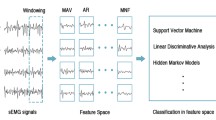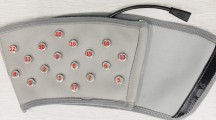Abstract
Surface electromyography-based gesture recognition was widely applied in human–computer interaction, hand rehabilitation, prosthetic control, and other fields. Electromyography (EMG) signals-based gesture classification usually relies on handcrafted feature extraction with intense subjectivity or convolutional neural networks with redundant structures to extract features. This paper converts the raw EMG signals into Gramian Angular Difference Field (GADF) and Gramian Angular Summation Field images. Four models were used to classify the pictures: K-nearest Neighbors (KNN), Generalized Learning Systems, Binary Trees, and Convolutional Neural Networks using MobileNetv1, and the proposed method was verified by using the public dataset NinaproDB2. Experimental results: When the window size is 300 ms, the step size is 10 ms, and KNN are used as the classification model, the average accuracy of EMG signals classification based on the GADF method is 98.17%, and the accuracy of exercises B, C and D was 96.65%, 95.53%, and 98.02%, respectively. The recognition accuracy was 7.92%, 14.25%, and 4.279% higher than the provided baseline.





Similar content being viewed by others
Data availability
No datasets were generated or analysed during the current study.
References
Wang, Y., Wu, Q., et al.: Deep back propagation-long short-term memory network based upper-limb sEMG signal classification for automated rehabilitation. Biomed. Signal Process. Control 40(3), 987–1001 (2020)
Bi, L., Feleke, A.G., et al.: A review on EMG-based motor intention prediction of continuous human upper limb motion for human-robot collaboration. Biomed. Signal Process. Control 51, 113–127 (2019)
Arteaga, M.V., Castiblanco, J.C., et al.: EMG-driven hand model based on the classification of individual finger movements. Biomed. Signal Process. Control 58, 101834 (2020)
Zhang, L., Long, J., et al.: Estimation of the continuous pronation—supination movement by using multichannel EMG signal features and Kalman filter: application to control an exoskeleton. Front. Bioeng. Biotechnol. 9, 771255 (2022)
Zou, Y., Cheng, L., et al.: Reconstruction of incomplete surface electromyography based on an adversarial autoencoder network. Biomed. Signal Process. Control 86, 105084 (2023)
Karnam, N.K., Turlapaty, A.C., et al.: Classification of sEMG signals of hand gestures based on energy features. Biomed. Signal Process. Control 70, 102948 (2021)
Zhang, L., Shi, Y., et al.: Real-time and user-independent feature classification of forearm using EMG signals. J. Soc. Inform. Display 27(2), 101–107 (2019)
Wang, N., Lao, K., et al.: The recognition of grasping force using LDA. Biomed. Signal Process. Control 47, 393–400 (2019)
Gao, Z., Wang, Y., et al.: A multifeatured time–frequency neural network system for classifying sEMG. IEEE Trans. Circuits Syst. II Express Briefs 69(11), 4588–4592 (2022)
Hazarika, A., Barman, P., et al.: Real-time implementation of a multidomain feature fusion model using inherently available large sensor data. IEEE Trans. Ind. Inf. 15(12), 6231–6239 (2019)
Xu, M., Chen, X., et al.: Cross-user electromyography pattern recognition based on a novel spatial-temporal graph convolutional network. IEEE Trans. Neural Syst. Rehab. Eng. 32, 72–82 (2024)
Fajardo, J.M., Gomez, O., et al.: EMG hand gesture classification using handcrafted and deep features. Biomed. Signal Process. Control 63, 102210 (2021)
Azhiri, R.B., Esmaeili, M., et al.: Raw EMG classification using extreme value machine. Biomed. Signal Process. Control 86, 105345 (2023)
Wei, Y., Zhou, J., et al.: A review of algorithm & hardware design for ai-based biomedical applications. IEEE Trans. Biomed. Circuits Syst. 14(2), 145–163 (2020)
Wang, W., Zhang, J., et al.: Motion intensity modeling and trajectory control of upper limb rehabilitation exoskeleton robot based on multi-modal information. Complex Intell. Syst. 8(3), 2091–2103 (2022)
Côté-Allard, U., Fall, C.L., et al.: Deep learning for electromyographic hand gesture signal classification using transfer learning. IEEE Trans. Neural Syst. Rehabil. Eng. 27(4), 760–771 (2019)
Ozdemir, M.A., Kisa, D.H., et al.: Hand gesture classification using time–frequency images and transfer learning based on CNN. Biomed. Signal Process. Control 77, 103787 (2022)
Karheily, S., Moukadem, A., et al.: SEMG time-frequency features for hand movements classification Expert Syst. Appl 210, 118282 (2022)
Xu, L., Zhang, K., et al.: Gesture recognition using dual-stream CNN based on fusion of sEMG energy kernel phase portrait and imu amplitude image. Biomed. Signal Process. Control 73, 103364 (2022)
Wu, Y., Liang, S., et al.: Prediction and classification of sEMG-based pinch force between different fingers. Expert Syst. Appl. 237, 121635 (2024)
Qi, P., Xu, H., et al.: Residual neural networks based on empirical mode decomposition for mitral regurgitation prediction. Biomed. Signal Process. Control 86, 105265 (2023)
Wang, W., Zhao, C., et al.: Research on multimodal fusion recognition method of upper limb motion patterns. IEEE Trans. Instrum. Meas. 72, 1–12 (2023)
Fu, R., Zhang, B., et al.: Gesture recognition of sEMG signal based on GASF-LDA feature enhancement and adaptive ABC optimized SVM. Biomed. Signal Process. Control 85, 105104 (2023)
Atzori, M., Gijsberts, A., et al.: Electromyography data for non-invasive naturally-controlled robotic hand prostheses. Sci. Data 1, 1–13 (2014)
Sahu, P., Singh, B.K., et al.: An improved feature selection approach using global best guided gaussian artificial bee colony for EMG classification. Biomed. Signal Process. Control 80, 104399 (2023)
Torres-Castilllo, J.R., Lopez-Lopez, C.O., et al.: Neuromuscular disorders detection through time-frequency analysis and classification of multi-muscular EMG signals using Hilbert-Huang transform. Biomed. Signal Process. Control 71, 103037 (2022)
Zhang, L., Bian, H., et al.: Subjects self-select forearm gestures identification based on post-processing and integrating sEMG sensors and as. Biomed. Signal Process. Control 85, 105023 (2023)
Qin, X., Yang, D., et al.: Research on emotion recognition of bimodal bioelectrical features based on d-s evidence theory. Biomed. Signal Process. Control 87, 105538 (2024)
Zhang, Y., Xia, C., et al.: Pattern recognition of hand movements based on multi-channel mechanomyography in the condition of one-time collection and sensor doffing and donning. Biomed. Signal Process. Control 91, 106078 (2024)
Tang, B., Li, R., et al.: A membership-function-based broad learning system for human–robot interaction force estimation under drawing task. Med. Biol. Eng. Compu. 61(8), 1975–1992 (2023)
Zhong, J., Li, J., et al.: An incremental cross-modal transfer learning method for gesture interaction. Robot. Auton. Syst. 155, 104181 (2022)
Li, G., Zou, C., Jiang, G., et al.: Multi-view fusion network-based gesture recognition using sEMG data. IEEE J. Biomed. Health Inf. 28(8), 4432–4443 (2024)
Bu, D., Guo, S., et al.: SEMG-based motion recognition of upper limb rehabilitation using the improved yolo-v4 algorithm. Life-Basel 12(1), 64 (2022)
Fu, Y., Song, W., et al.: Feature recognition in multiple CNNs using sEMG images from a prototype comfort test. Comput. Methods Programs Biomed. 243, 107897 (2024)
Nan, Y., Ju, J., et al.: A-mobilenet : an approach of facial expression recognition. Alex. Eng. J. 61(6), 4435–4444 (2022)
Xiao, F., Chen, Y., et al.: GADF/GASF-HOG: feature extraction methods for hand movement classification from surface electromyography. J. Neural Eng. 17(4), 046016 (2020)
Sun, B., Song, B., et al.: A multiscale feature extraction network based on channel-spatial attention for electromyographic signal classification. IEEE Trans. Cogn. Dev. Syst. 15(2), 591–601 (2023)
Zabihi, S., Rahimian, E., et al.: TraHGR: transformer for hand gesture recognition via electromyography. IEEE Trans. Neural Syst. Rehabil. Eng. 31, 4211–4224 (2023)
Funding
Xi'an Beilin District Science and Technology Plan Project (GX2307). Colleges and universities scientific and technological personnel service enterprise project (2024JH-GXFW-0019).
Author information
Authors and Affiliations
Contributions
Huarui Bian: Conceptualization, Writing – original draft, Software. Lei Zhang: Data curation, Methodology, Writing – review & editing.
Corresponding author
Ethics declarations
Competing interests
The authors declare no competing interests.
Ethics approval
This study involving human participants has been reviewed and approved by the Medical and Experimental Animal Ethics Committee of Northwestern Polytechnical University (202002020). In accordance with national legislation and institutional requirements, written informed consent from participants was not required for this study.
Consent to participate
Informed consent was obtained from all individual participants included in the study.
Consent to publish
The authors affirm that human research participants provided informed consent for publication of the images.
Additional information
Publisher's Note
Springer Nature remains neutral with regard to jurisdictional claims in published maps and institutional affiliations.
Rights and permissions
Springer Nature or its licensor (e.g. a society or other partner) holds exclusive rights to this article under a publishing agreement with the author(s) or other rightsholder(s); author self-archiving of the accepted manuscript version of this article is solely governed by the terms of such publishing agreement and applicable law.
About this article
Cite this article
Bian, H., Zhang, L. Gesture recognition based on Gramian angular difference field and multi-stream fusion methods. SIViP 19, 120 (2025). https://doi.org/10.1007/s11760-024-03565-8
Received:
Revised:
Accepted:
Published:
DOI: https://doi.org/10.1007/s11760-024-03565-8




